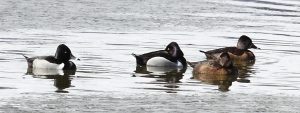
Photo: Kentucky Department Fish And Wildlife
The first snippets of snow fell this week, making most people frown, but put a smile on the faces of Kentucky waterfowl hunters. The cold weather the week before the waterfowl season opener on Thanksgiving Day is a good sign.
“Waterfowl hunting in Kentucky is nearly 100 percent weather dependent,” said Wes Little, migratory bird biologist for the Kentucky Department of Fish and Wildlife Resources. “We will have more birds to hunt if we get cold weather to the north of Kentucky. If we continue with this cold weather, we should have a good opener.”
Little said fantastic habitat conditions for waterfowl await those birds. “The moist soil vegetation such as wild ryes, annual smartweeds, millets and sedges are looking great across the state. The habitat is here and population wise, we are living the glory days.”
A slight dip in duck numbers in 2018 resulting from adverse weather conditions during breeding season in the prairie-pothole region on the northern Great Plains and Canada in 2017 should not concern waterfowl hunters. “We are still well above the long term average for duck numbers,” Little said. “This trend is basically a blip and should not impact hunting at all.”
New public waterfowl hunting opportunities on Sloughs Wildlife Management Area (WMA) in Henderson and Union counties offer a chance for excellent hunting each week of the season. Little explained hunters who have not put in for a quota hunt on the area may try for a minimum of 10 slots via a weekly draw each Monday night of the season.
“Nine of those slots are on the Jenny Hole Unit with one on the Sauerheber Unit,” Little explained. “More slots may be available if those drawn for quota hunts on the area don’t check in on the Sunday before their hunts.”
Waterfowl hunters on Ballard WMA in Ballard County, an anchor of Kentucky waterfowl hunting for decades, no longer have to hunt from blinds. “For the first time, a few boat-in hunting spots are available on Ballard WMA,” Little said. “There are many wade and shoot opportunities as well.”
Boatwright WMA, also in Ballard County, and Doug Travis WMA in Carlisle and Hickman counties, offer daily walk-in waterfowl hunting. For more information on these opportunities, refer to the 2018-2019 Kentucky Waterfowl Hunting Guide available in a printable PDF format at the Kentucky Fish and Wildlife webpage at www.fw.ky.gov. There is no longer a paper version of this guide.
Little said Cedar Creek Lake in Lincoln County, Barren River Lake in Allen and Barren counties and Green River Lake in Adair and Taylor counties offer some of the best waterfowl hunting in the central Kentucky region. He also recommended Cave Run Lake for duck hunting in east Kentucky, especially later in the season. Goose hunting is not permitted on most of Cave Run Lake. The Ohio River also offers good later season duck and goose hunting.
Hunters without a boat and other gear needed to hunt large bodies of water should try farm ponds. “Farm ponds always provide opportunity,” Little said. “You must get permission from the landowner. Do not be afraid to ask, many landowners with resident goose issues are open to waterfowl hunters. Do not forget to close the gate behind you; that is the number one way to lose hunting permission on a farm.”
Steel shotshells in No. 2 through No. 4 work well for ducks while those in BB through No. 2 make good goose loads. “The modern non-toxic loads with tungsten or bismuth allow hunters to use smaller shot sizes,” Little said.
“I mostly use 3-inch, steel shotshells with 1 1-4 ounces of shot for waterfowl hunting,” Little said. Waterfowl hunters may not use or possess lead shot while hunting.
Duck, coot and merganser season opens Thanksgiving Day, Nov. 22 and closes Nov. 25. This season opens again Dec. 3 and closes Jan. 27, 2019. Goose season also opens Thanksgiving Day, Nov. 22 and closes Feb. 15, 2019.
As a reminder, waterfowl hunters must complete a short survey and get their Harvest Information Program (H.I.P.) confirmation number before hunting. Visit the Kentucky Fish and Wildlife homepage at www.fw.ky.gov and click on the “My Profile” tab to begin. The process takes less than 5 minutes.
In addition to the H.I.P. confirmation number, waterfowl hunters need a valid Kentucky hunting license as well as a Kentucky Migratory Bird – Waterfowl Hunting Permit along with a signed Federal Duck Stamp to be legal waterfowl hunters.
Waterfowl hunting provides a fun reason to get outside in winter while providing excellent tasting, nutritious table fare. A meal featuring properly cooked duck is as good as any expensive restaurant
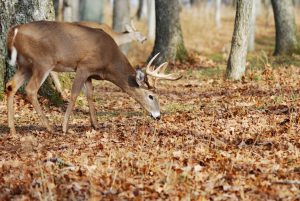
Photo: Kevin Kelly/Kentucky Department Fish and Wildlife
Many deer hunters rejoiced this past weekend over a break in a weather pattern that had been alternating between stifling heat and soaking rains.
A cool down coincided with the two-day gun season for youth deer hunters. It also excited archery and crossbow hunters getting into the woods, blinds and tree stands.
“It wasn’t really fit to do much but go hunting,” said Gabe Jenkins, deer and elk program coordinator with the Kentucky Department of Fish and Wildlife Resources. “We saw good participation over the weekend.”
On deck for deer hunters in Kentucky are the October muzzleloader (Oct. 20-21), modern gun (Nov. 10-25) and late muzzleloader seasons (Dec. 8-16) before the free youth weekend on Dec. 29-30, 2018.
Difficult hunting conditions defined the first six weeks since archery deer season arrived at the start of September, which also ushered in numerous changes to deer hunting regulations.
The changes are detailed in the updated version of the Kentucky Hunting and Trapping Guide, on the department’s website at fw.ky.gov and in videos posted on the department’s Facebook page and YouTube channel.
“What I’ve been telling people is, if you’re a deer hunter in this state, read the hunting guide because something that affects you has changed,” Jenkins said.
Major differences from last season:
- The statewide and youth deer permits allow for the harvest of up to four deer, either one antlered and three antlerless or four antlerless.
- The modern gun deer season is 16 days statewide.
- A total of 32 counties have been moved up into a different zone.
- Hunters can take as many deer as allowed for each zone. In order to take more than four deer statewide, an additional deer permit must be purchased.
- Hunters in Zones 2 and 3 can harvest no more than four deer. In Zone 3, only one antlerless deer can be taken with a firearm.
- The bag limit in Zone 4 is two deer but only one can be an antlerless deer. Antlerless deer can be harvested during the archery season, crossbow season, free youth weekend or the last three days of the December muzzleloader season. Again, the statewide bag limit of one antlered deer applies.
Hunters are still allowed only one antlered deer statewide regardless of zone, method or season. In Zone 1, hunters can still harvest an unlimited number of antlerless deer with the statewide deer permit and additional deer permit.
The changes encourage greater harvest of does and increased deer harvest in areas where a reduction in herd numbers is sought. At the same time, they are designed to foster a bounce back in areas of east Kentucky hit hardest by last year’s epizootic hemorrhagic disease (EHD) outbreak.
“The new regulations are intended to help meet those objectives,” Jenkins said.
Jenkins said this week there has been one confirmed case of EHD with test results pending on five others, most from north of Interstate 64 and east of Interstate 75.
“I wouldn’t be surprised if we see an uptick in harvest with people wanting to try to fill their four-deer limit,” Jenkins said. “But we also know that three-quarters of our total harvest comes during the modern gun season. That’s the key. If we get a bad weather weekend or two in there, that’s going to have an effect.”
Hunters harvested 136,026 deer during the 2017-18 season, the fifth highest total on record, and the state’s deer herd remains robust overall.
“Things are good,” Jenkins said. “We had a very wet winter and there’s plenty of forage for both adults and fawns, so we expect to see high survival. Traditionally, you have a stress period in July and August. That did not exist this year. They’ve had plenty of groceries on the landscape, so they should be in prime condition health-wise.”
While September’s harvest was down year-over-year, understandable considering the unkind heat and rain, it remained higher than the 10-year average.
Hunters reported taking 4,654 deer during this month’s youth-only gun season weekend, second only to the 2015 season.
That year, the statewide mast survey noted poor white oak acorn production with red oaks rated average. Early returns from mast surveys conducted this year point toward uneven acorn production. Deer will frequent areas around white oaks littering the ground with acorns first before turning attention to red oaks.
“They’re going be more active in weather like this than they are in 90-degree temperatures,” Jenkins said. “They’re going to do what they’re going to do breeding wise when the season is right. However, if conditions are more conducive to eat and be up and moving, they’re going to.
“Right now the key is acorns. Deer are just going to sit there and munch on acorns all day long.”
A chill in the air gets hunters thinking about deer in Kentucky. The best part is its arrival this year comes with plenty of season still left.
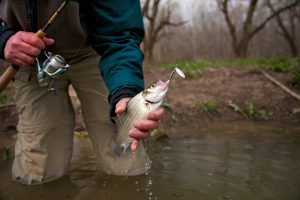
Photo: Kentucky Department Fish And Wildlife
This spring seems like one long continuation of late winter. As soon as we get a warm day, the temperature plunges and we are back in February again. It even snowed on Monday of the third week of April.
This up and down weather combined with cold rains has the spring fishing season behind by a few weeks. The spawning runs of white bass into the headwaters of reservoirs are scattershot so far this spring, with some movement followed by retreat.
“I don’t think the white bass have really had a chance to run yet,” said Ron Brooks, director of Fisheries for the Kentucky Department of Fish and Wildlife Resources. “I think the fluctuating water temperatures are screwing them up a bit. We need a sustained warm front to get them going.”
Water temperatures are in the low 50s in most reservoirs and streams across Kentucky.
Anglers fishing the headwaters of Taylorsville Lake found rewarding, but sporadic, fishing over the last week. “Last Thursday, I took home six white bass, but on Friday, I took home 10, at least four of them over 15 inches,” said Clifford Scott, internal policy analyst for Kentucky Fish and Wildlife. “I had to walk quietly out of there because I had the biggest stringer of fish.”
Scott took his fish with a combination of old-school 2-inch curly-tailed grubs in white and yellow along with a 2-inch Bobby Garland Baby Shad in pink and pearl.
“I saw small shad all over the place,” Scott said. “Once I saw them, I switched to the Baby Shad. You had to fish for the white bass, they were not on a hard run, but produced enough action to keep your interest.”
The upper part of Taylorsville Lake WMA grants bank access to anglers that produces fishing comparable to those in boats.
Mike Hardin, assistant director of Fisheries, caught some white bass in the upper reaches of Taylorsville Lake this past weekend. “We caught them above the first riffle from the impounded water,” he said. “We caught a mixed bag of different sizes and caught more in the evening than in the morning. The males were marked up in breeding colors. We caught a few females, so they are already staging for the spawn.”
White bass populations are by nature cyclic, and good fishing often erupts in lakes over the course of a year or two.
Green River Lake is one of those lakes poised for a white bass breakout. Southwestern Fisheries District biologist Eric Cummins and crew conducted white bass population sampling on the lake last year. They found excellent reproduction in 2014 for white bass, producing an expanding population of fish 14 inches and longer in the lake.
Last week, some bass anglers fishing a tournament on Green River Lake reported incidental catches of white bass while fishing crankbaits for largemouth bass. Anglers should search the Robinson Creek arm from Wilson Creek up to the KY 76 Bridge (Knifley Road) and in the Green River arm above Holmes Bend.
Bank anglers can access the upper end of the Robinson Creek arm at the Elkhorn Ramp and the Wilson Creek Recreation Area. They may also access the upper section of the Green River arm at the Snake Creek Ramp and other roads on the Green River WMA in that area.
Cave Run Lake is another reservoir with growing numbers of white bass. Population surveys conducted in 2017 show high numbers of larger fish, which should mean good fishing in 2018. Search for surface activity to find white bass in spring on the lake.
The fishing peaks in summer on Cave Run, when white bass get in the “jumps” by trapping shad against the surface and ripping through them. The confluence near the mouth of Buck Creek as well as the areas around the Clay Lick and Alfrey boat ramps make excellent places to search for them when it gets hot. Any shad imitating topwater cast into the jumps will get smoked.
Some anglers caught fish in the Broad Ford area in the headwaters of Nolin River Lake a few weeks ago, but the fishing slowed with the cold rains that accompanied major frontal passages earlier in April. The sustained warm weather in the upcoming forecast will draw waves of white bass into Nolin River Lake above Bacon Creek Ramp.
Fast and furious fishing during the spring runs makes white bass one of the most popular fish anglers pursue. When they are on, you can catch several fish on consecutive casts.
In-line spinners like the venerable Rooster Tail in white, chartreuse and pink all score white bass. You can work an in-line spinner near the surface or let it sink a few feet and retrieve. Vary the depths of the retrieve until you hit fish.
Like what Scott found last week, small shad-shaped soft plastic lures or curly tailed grubs also attract white bass. Some anglers fishing the headwaters of reservoirs suspend 1/16- to 1/32-ounce white feather or hair jigs under bobbers and let them drift in the current. Change the depth of the jig until you find white bass.
Anglers may keep 15 white bass daily, but only five of the daily limit may be longer than 15 inches. White bass fishing gives you a fantastic reason to buy your fishing license, so don’t forget to get one if you haven’t already.
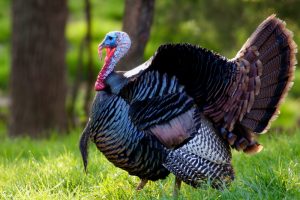
Photo: Kentucky Department Fish and Wildlife
The landscape awakens almost spontaneously from its winter slumber. Winter flocks break up into smaller groups. Innumerable turkey calls and lifelike decoys reappear at sporting goods retailers.
Turkey hunters interpret these occurrences as signs that it will not be long before they are easing into their spots before dawn, filled with anticipation.
In Kentucky, hunters still have ample time to scout and develop a game plan to increase their odds of success in the upcoming spring turkey season. This year, Kentucky’s youth-only season is the weekend of April 7-8. The start of the 23-day general statewide season follows on April 14. It ends May 6.
“Start at the computer then get out in the field to find birds,” said Zak Danks, wild turkey program coordinator with the Kentucky Department of Fish and Wildlife Resources. “Know some different approaches you might take and where you can move based on gobbling you hear once the season starts. Think about some good set-up spots or places to put your decoys, or vantage points to see birds.”
Virtual scouting can save precious time for hunters looking to hunt public land. Topographic maps and satellite views may reveal access points, existing trails, open fields, wooded areas, elevation changes and creeks or fences where approaching gobblers could hang up. Kentucky offers dozens of wildlife management areas and other lands open for public use. As a reminder, turkey calling is not allowed from March 1 until the opening of the youth-only season, and from the close of that season until the opening of the statewide season. Hunters may still use an owl, crow or other calls to locate turkeys while scouting.
It is always a good practice before the season to shoot your shotgun at a paper turkey head target using different brands of turkey loads. By patterning a shotgun ahead of time, the hunter knows the shotgun will shoot where it is aimed and deliver an acceptable number of pellets to the turkey’s vital area (head and neck).
“One thing I’ve learned over the past several years is just how good the hunting can be later in the season,” Danks said. “Last year, in particular, I had hunters contacting me well after the season ended saying they were still hearing turkeys gobble. So don’t get discouraged if you don’t have success early on. There’s still time to find turkeys throughout the season.”
In Kentucky, the spring hunting seasons are timed to give gobblers enough time to breed hens before subjecting the birds to hunting pressure. Kentucky Fish and Wildlife monitors turkey reproduction on a statewide scale through annual summer brood surveys.
Weather during the nesting period in May and June influences reproductive success. Heavy rains in Kentucky and surrounding states during that timeframe last year affected nesting success, which reflected in a statewide average of 1.2 pounds per hen. A figure of 2.0 or higher is optimal. Hunters should expect to encounter fewer of the more easily fooled jakes as a result this season.
Kentucky annually ranks first or second among surrounding states in the number of turkeys taken per square mile.
Hunters took a record number of birds during the 2010 spring season and have averaged more than 31,000 birds over the seven seasons since.
Last spring, hunters reported taking 33,061 birds, which represents a 6 percent increase over the previous year and the third highest total on record. Muhlenberg County led all counties with hunters reporting 681 birds taken there. Looking at it differently, Pendleton County led the state with 1.76 birds harvested per square mile.
The majority of counties are showing a stable to increasing harvest trend over the past decade. Some counties are exhibiting lower harvest totals. In response, Kentucky Fish and Wildlife is expanding efforts to monitor the turkey population and reproduction. Feedback from hunters will play an important role.
A new spring hunting log and post-season survey will soon be available on the department’s website at www.fw.ky.gov. On the homepage, type “Spring Turkey Hunting” into the search box. The log serves to collect information about a hunter’s daily hunting effort, number of turkeys seen, heard and harvested, observations about weather and other species observed. The post-season survey will include questions about spring hunting experiences.
“Our harvest totals tell us that we’re still in a pretty good situation on a statewide level,” Danks said. “We are hearing from people who tell us they’re not seeing as many turkeys as they had in the past. Most of that is from counties that have shown a decrease in harvest. What’s the reason? It’s difficult to determine on a statewide scale when all we’ve had to go on is harvest. We need information on hunter effort on a county level.
“The information gained from these hunter surveys and logs should help us track trends across the state.”
Hunters are allowed a limit of two bearded birds during the spring season, but no more than one bearded bird may be taken in a day.
The 2018 Kentucky Spring Hunting Guide provides information about current regulations, licenses and permits, legal equipment, safety tips and more. Find it online at fw.ky.gov or wherever licenses are sold.
Hunters also will have an opportunity to have their questions about spring turkey season answered during a special “Kentucky Afield” TV call-in show scheduled Saturday, March 24. The live one-hour show will air at 8 p.m. Eastern/7 p.m. Central on Kentucky Educational Television (KET). Joining host Chad Miles for the show will be Danks and pioneering turkey hunter Harold Knight.
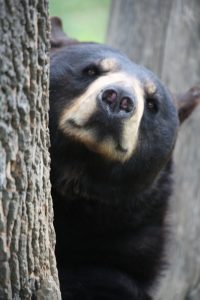
Photo: Kentucky Department Fish and Wildlife
Viewers of “Kentucky Afield” television picked up their phones and took to social media last weekend to submit more than 200 questions for the annual fall hunting call-in show.
Kentucky Department of Fish and Wildlife Resources wildlife biologists Gabe Jenkins and John Morgan, along with Sgt. Rufus Cravens of the department’s Law Enforcement Division, joined “Kentucky Afield” host Chad Miles for the hour-long show that aired live on Sept. 16 on Kentucky Educational Television. The panel could not get to all of the questions before the credits started rolling.
Below, Kentucky Fish and Wildlife personnel answered a handful of the questions that did not make it on-air. Viewers who missed the live show can watch a full replay on YouTube. Enter “KYAfield” in the search box on the YouTube homepage.
Will Kentucky Fish and Wildlife consider adjusting deer seasons due to the EHD (Epizootic Hemorrhagic Disease) outbreak? – Eddie from Morgan County
GABE JENKINS, Deer and Elk Program Coordinator, Kentucky Fish and Wildlife: We will not be implementing an emergency regulation to shorten or close deer season in 2017 in any county due to the EHD outbreak. We encourage folks to report all dead deer they find using our online reporting system.
After the outbreak has ceased, we will evaluate the number reported along with the harvest data from the 2017 season and make our recommendations for the 2018 season at the December meeting of the Fish and Wildlife Commission. Deer are prolific breeders, and the population will rebound within a couple years.
Lastly, if your area has experienced a severe die-off, I would encourage hunters to participate in some self-restraint and pass once you have taken enough deer to fill your freezer for the year.
How far west have elk traveled in Kentucky? – Wayne from Marion County
JENKINS: We receive reports of elk outside the elk zone almost every year. In the early years of elk restoration, we saw elk leave the elk zone more frequently. We’ve had reports of elk as far west as Lake Cumberland and one elk went to North Carolina. We have had elk harvested outside the elk zone in Bath, Carter, Laurel, Madison, Wayne and Wolfe counties.
What resources are available through Kentucky Fish and Wildlife to assist with wildlife habitat improvement? – Gary from Grayson
BEN ROBINSON, Wildlife Division Assistant Director, Kentucky Fish and Wildlife: Kentucky Fish and Wildlife is committed to assisting landowners with wildlife habitat improvement on their property. We employ more than 30 wildlife biologists who specialize in assisting private landowners with habitat management projects. From tips about improving food sources for deer and turkey to navigating cost share programs through the federal Farm Bill, we have someone available to assist you.
For more information, visit our web site at fw.ky.gov or call 1-800-858-1549 and ask for the phone number of your local private lands or farm bill biologist.
Does prescribed burning on private and public lands benefit wild turkeys? Where can I find more information? – Tony from Montgomery County
ROBINSON: Kentucky Fish and Wildlife considers prescribed fire an essential management tool for private landowners and publicly managed Wildlife Management Areas. Prescribed fires are carefully planned and managed by highly trained burn crews for containment to select areas.
We regularly use prescribed burning on grasslands and timbered areas to benefit a host of game and non-game species, including wild turkey.
Prescribed fire has many benefits. Fire removes old vegetation and stimulates new growth, providing a lush food source for wildlife. Fire promotes oak regeneration in our forests resulting in more acorns, a staple food source for many species. By removing dead vegetation, fire also creates bare ground, a necessity for bobwhite quail and other ground dwelling birds.
For more information on prescribed fire in Kentucky, visit the Kentucky Prescribed Fire Council’s website www.kyfire.org.
Why was bear season closed in McCreary County on public land? – David from McCreary County
JOHN HAST, Bear Program Coordinator, Kentucky Fish and Wildlife: Bear numbers are still low in McCreary County. Kentucky Fish and Wildlife’s philosophy on bear management is to allow as much hunter opportunity as the bear population will allow. What we may sacrifice in hunter opportunity in McCreary County for a few years will pay off when bears have a chance to grow within the county and expand more fully into surrounding counties, such and Pulaski and Rockcastle.
Great bear habitat lies just to the north of McCreary County within the Daniel Boone National Forest and it has the potential to provide a great place for bears and bear hunters in the future.
A population of bears is very slow in its growth and patience is necessary to see any big leaps in the season quota. You can rest assured that Kentucky Fish and Wildlife is actively monitoring bears in McCreary County in order to improve our population models. When the bear population is ready, hunters will once again be able to hunt public land.
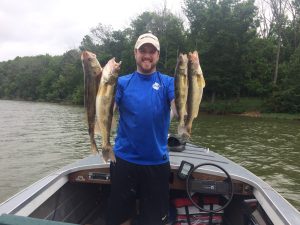
Photo: Kentucky Department Fish and Wildlife
With every passing season, anglers are building their knowledge base about how to catch saugeye stocked in a handful of central and northern Kentucky lakes.
A saugeye is a fast-growing cross between a walleye and sauger that can reach 15 to 19 inches in its second year. The hybridization is evident in the species’ physical appearance. Saugeye display the faint saddle markings of a sauger and the white fin tips of a walleye. Unlike either, it features black smudges on its dorsal fin.
Three lakes – 317-acre Guist Creek Lake in Shelby County, 148-acre Bullock Pen Lake in Owen County and 175-acre A.J. Jolly Lake in Campbell County – received experimental stockings of the species in 2013 and five have been stocked this year by the Kentucky Department of Fish and Wildlife Resources.
Guist Creek Lake received more than 15,000 fingerlings this spring. Anglers have reported good success in recent weeks fishing jigs off mud flats in 4 to 10 feet of water.
Paul Wilkes and Dane Balsman had never tried fishing for saugeye before they visited Guist Creek Lake one day in late June. They spoke with other anglers and studied bottom contour maps available on Kentucky Fish and Wildlife’s website at fw.ky.gov beforehand.
“We were able to identify some flats that we wanted to hit and then went out and graphed some baitfish near the drop-offs of those flats,” said Wilkes, fisheries program coordinator with Kentucky Fish and Wildlife. “We went out there with a mindset of if we caught one or two we were going to be pumped because this was a new species for us.”
The two reeled in 11 saugeye, including one that weighed 4.5 pounds and two others that weighed better than 3 pounds.
“We went out there and tried it and tried a few different drop-offs we mapped,” Wilkes said. “We stuck to the basics of jigging slowly in the areas we had identified. Strikes were kind of a thud, where you almost thought you were hung up until you really pulled it in. Once we found the fish, it seemed like they were in small schools. You’d catch several.”
Minnow or worm-tipped jigs or small shad-imitating crankbaits are good options for saugeye, as are small suspending jerkbaits or swimbaits in grey and white. Wilkes and Balsman, urban fisheries program coordinator with Kentucky Fish and Wildlife, found bladed jig heads with chartreuse bodies worked best for them.
Mike Hardin enjoyed similarly good fortune on Guist Creek Lake this spring fishing a little deeper in 8 to 10 feet of water.
“If you look at the fishing reports from saugeye lakes in Kentucky and Ohio, you see a lot of reports of anglers finding them in shallow water on crankbaits,” said Hardin, assistant Fisheries Division director with Kentucky Fish and Wildlife. “For a long time, I looked and looked and fished extremely shallow water jigging and picking up the occasional saugeye.
“We pulled off the bank and found wads of baitfish in 8- to 10-feet of water and it was game on. Fish close to the bottom, just like walleye fishing.”
He’s also had caught saugeye on Taylorsville Lake. Fisheries biologists believe good saugeye fishing could be in the cards this fall on Salt River above Taylorsville Lake based on population sampling from last fall.
“It seemed like there was definitely a push up there in the river. There’s going to be crappie and saugeye and bass, a little bit of everything,” said David Baker, Central Fisheries District biologist with Kentucky Fish and Wildlife. “Honestly, I think we’re going to be getting a lot of phone calls about saugeye in Taylorsville here in the next year or two.”
This year, the Kentucky Department of Fish and Wildlife Resources stocked more than 150,000 fingerlings in five lakes with Taylorsville Lake receiving more than 115,000 saugeye fingerlings.
Also receiving saugeye fingerlings were Guist Creek Lake, 92-acre Boltz Lake in Grant County and A.J. Jolly Lake in Campbell County. Lake Carnico, a 114-acre lake in Nicholas County, received its first saugeye stocking this year.
“It was a ton of fun and we were able to get on some really nice fish,” Wilkes said. “It definitely exceeded our expectations.”
For more information about saugeye fishing in Kentucky, including special regulations, consult the current Kentucky Fishing and Boating Guide. It is available online at fw.ky.gov and wherever licenses are sold.
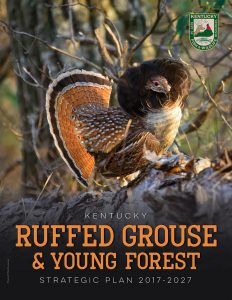 A newly published plan developed by the Kentucky Department of Fish and Wildlife Resources offers a long-range strategy to help ruffed grouse populations rebound in eastern Kentucky after years of decline.
A newly published plan developed by the Kentucky Department of Fish and Wildlife Resources offers a long-range strategy to help ruffed grouse populations rebound in eastern Kentucky after years of decline.
The Ruffed Grouse and Young Forest Strategic Plan looks 10 years out and its success hinges on an array of partners working together to create the young forest habitat on which grouse and other woodland species can thrive.
“This will be an ambitious effort, aimed at turning the tide for the ruffed grouse,” Kentucky Fish and Wildlife Commissioner Gregory K. Johnson said. “There is no doubt this is a challenge that can become a real opportunity. We are accepting this challenge with every intent to be successful. We will need your help – our sportsmen, our partners, our colleges and universities, and our forest products industry. Only together can we be successful restoring this magnificent game bird to our landscape.”
The strategic plan, more than two years in the making, incorporates input received from the public and other stakeholders. It is available on Kentucky Fish and Wildlife’s website at fw.ky.gov.
Grouse are upland birds that spend much of their time on the ground. Prized by hunters for the challenge it presents, and renowned for its explosive take-offs when flushed, the species needs a mosaic of habitat.
Hunters in Kentucky enjoyed decades of high grouse densities last century; a direct result of the timber harvest, farm abandonment and surface mine reclamation that took place in preceding years.
Much of eastern Kentucky’s forests have matured since then into more open stands that do not provide the dense protective cover or food sources grouse need to survive and reproduce. At the same time, in many forests a lack of management has favored red maples in the understory. Maples do not produce the protein-rich nuts like the acorns that mature oak trees do. The hard mast helps grouse survive winter in better condition, leading to better reproduction in spring.
“The ideal recipe for grouse is a landscape that is at least 75 percent forested, at least 5,000 to 10,000 acres, and at least 20 to 30 percent young forests. The bigger and more diverse in terms of forest stand ages and species diversity, the better,” said Zak Danks, ruffed grouse and wild turkey program coordinator with Kentucky Fish and Wildlife. “A large clear-cut that is 10 years old is prime for grouse, but only for another 10-15 years. They also use older forest for nesting and foraging. You need that mix of young and old forest together. Patches of cutting don’t have to be that big – 20 to 40 acres is ideal – but you need a lot of those patches clustered within an area and across the surrounding landscape.”
The strategic plan covers the next 10 years and lays the groundwork for success far beyond that timeframe.
“The department is committed to working on grouse,” Danks said. “Over the next 10 years, we need to take a targeted approach for grouse. The objectives outlined in this plan will not be easy to accomplish, but provide the only real way to get grouse back.”
A collaborative, science-guided approach to habitat management is at the heart of the new strategic plan.
It calls for Kentucky Fish and Wildlife working with federal, state and local agencies, as well as corporations and private landowners to manage forests on focus areas by creating habitat beneficial to grouse and other wildlife. Focus areas may include wildlife management areas, state forests, the Daniel Boone National forest and private lands.
A successful outcome will require a commitment to sustainable forest management. This includes commercial timber harvests and noncommercial habitat treatments designed to stimulate plant growth for grouse broods, high stem densities for year-round cover and oak regeneration for the future forests, while maintaining select mature, acorn-producing trees to help boost oak stands in the forest. Public outreach to promote the importance of young forest habitat for woodland species will be key.
“In the grouse woods, a hunter often gets only a fleeting glimpse of his flushing quarry, and shots are often taken on faith,” Danks said. “We must embrace the challenge of grouse restoration now, and on behalf of grouse, blue-winged warblers, oaks and the suite of other species that cannot lobby for their own existence.”
 Weather
Weather Traffic
Traffic @LouisvilleDispatch
@LouisvilleDispatch @LouisvilleDisp
@LouisvilleDisp Subscribe
Subscribe